Investigation of Dual Network Construction for Toughening in Bio-Based Polyamide Composites
Abstract
1. Introduction
2. Materials and Methods
2.1. Materials
2.2. Preparation of Samples
2.3. Characterization Methods
3. Results and Discussion
3.1. Rheological Behavior and Interfacial Interaction of Composite Systems
3.2. Selection of Toughener in Composite System
3.3. Construction of Interpenetrating Network Structure
4. Conclusions
Supplementary Materials
Author Contributions
Funding
Institutional Review Board Statement
Data Availability Statement
Conflicts of Interest
References
- Wang, Z.L.; Xu, J.L.; Qian, Y.; Shibraen, M.H.M.A.; Jian, X.; Yang, S.G. Hydrothermal Treatment of Polyamide 6 with Presence of Lanthanum Chloride. Polym. Sci. 2016, 34, 399–406. [Google Scholar] [CrossRef]
- Zhou, C.X.; Dong, S.Y.; Zhu, P.; Liu, J.G.; Wang, D.J.; Dong, X. Strain-Induced Form Transition and Crystallization Behavior of the Transparent Polyamide. Polymers 2021, 13, 1028. [Google Scholar] [CrossRef] [PubMed]
- Rolland, H.; Saintier, N.; Raphael, I.; Lenoir, N.; King, A.; Robert, G. Fatigue Damage Mechanisms of Short Fiber Reinforced PA66 as Observed by In-Situ Synchrotron X-ray Microtomography. Compos. Part B Eng. 2018, 143, 217–229. [Google Scholar] [CrossRef]
- Gan, D.; Liu, Y.; Hu, T.; Fan, S.; Cui, L.; Liao, G.; Xie, Z.; Zhu, X.; Yang, K. Pseudo-Eutectic of Isodimorphism to Design Biaxially-Oriented Bio-Based PA56/512 with High Strength, Toughness and Barrier Performances. Polymers 2024, 16, 1176. [Google Scholar] [CrossRef]
- Zhou, C.X.; Zhu, P.; Wang, Y.; Xing, Q.; Wen, T.; Dong, X.; Wang, D.J. Relaxation Behavior, Crystallization and Mechanical Property of Long Chain Polyamides via Thermodynamic Technologies. Mater. Today Commun. 2023, 35, 105568. [Google Scholar] [CrossRef]
- Ruehle, D.A.; Perbix, C.; Castañeda, M.; Dorgan, J.R.; Mittal, V.; Halley, P.; Martin, D. Blends of Biorenewable Polyamide-11 and Polyamide-6,10. Polymer 2013, 54, 6961–6970. [Google Scholar] [CrossRef]
- Martino, L.; Basilissi, L.; Farina, H.; Ortenzi, M.A.; Zini, E.; Di Silvestro, G.; Scandola, M. Bio-Based Polyamide 11: Synthesis, Rheology and Solid-State Properties of Star Structures. Eur. Polym. J. 2014, 59, 69–77. [Google Scholar] [CrossRef]
- Jones, N.A.; Atkins, E.D.T.; Hill, M.J.; Cooper, S.J.; Franco, L. Polyamides with a Choice of Structure and Crystal Surface Chemistry. Studies of Chain-Folded Lamellae of Nylons 8 10 and 10 12 and Comparison with the other 2N 2(N+1) Nylons 4 6 and 6 8. Macromolecules 1997, 30, 3569–3578. [Google Scholar] [CrossRef]
- Corté, L.; Rebizant, V.; Hochstetter, G.; Tournilhac, F.; Leibler, L. Toughening with Little Stiffness Loss: Polyamide Filled with ABC Triblock Copolymers. Macromolecules 2007, 39, 9365–9374. [Google Scholar] [CrossRef]
- Corté, L.; Beaume, F.; Leibler, L. Crystalline Organization and Toughening: Example of Polyamide-12. Polymer 2005, 46, 2748–2757. [Google Scholar] [CrossRef]
- Zhou, C.X.; Zhu, P.; Liu, X.R.; Dong, X.; Wang, D.J. The Toughening Mechanism of Core-Shell Particles by the Interface Interaction and Crystalline Transition in Polyamide 1012. Compos. Part B Eng. 2021, 206, 108539. [Google Scholar] [CrossRef]
- Kinoshita, Y. An Investigation of the Structures of Polyamide Series. Makromol. Chem. 1959, 33, 1–20. [Google Scholar] [CrossRef]
- Bledzki, A.K.; Gassan, J. Composites Reinforced with Cellulose Based Fibres. Prog. Polym. Scien. 1999, 24, 221–274. [Google Scholar] [CrossRef]
- Oliver-Ortega, H.; Méndez, J.A.; Espinach, F.X.; Tarrés, Q.; Ardanuy, M.; Mutjé, P. Impact Strength and Water Uptake Behaviors of Fully Bio-Based PA11-SGW Composites. Polymers 2018, 10, 717–729. [Google Scholar] [CrossRef] [PubMed]
- Ricciardi, M.R.; Papa, I.; Langella, A.; Langella, T.; Lopresto, V.; Antonucci, V. Mechanical Properties of Glass Fibre Composites based on Nitrile Rubber Toughened Modified Epoxy Resin. Compos. Part B Eng. 2018, 139, 259–267. [Google Scholar] [CrossRef]
- Qian, M.; Sun, Y.; Xu, X.; Liu, L.; Song, P.; Yu, Y.; Wang, H.; Qian, J. 2D-Alumina Platelets Enhance Mechanical and Abrasion Properties of PA612 via Interfacial Hydrogen-Bond Interactions. Chem. Eng. J. 2017, 308, 760–771. [Google Scholar] [CrossRef]
- Xu, Z.; Gao, C. In situ Polymerization Approach to Graphene-Reinforced Nylon-6 Composites. Macromolecules 2010, 43, 6716–6723. [Google Scholar] [CrossRef]
- Lei, G.; Bo, Y.; Li, L.P.; Yang, M.B. Nylon-6/Graphene Composites Modified through Polymeric Modification of Graphene. Compos. Part B Eng. 2015, 73, 49–56. [Google Scholar]
- Jancar, J.; DiAnselmo, A.; DiBenedetto, A.T. Failure Mechanics in Elastomer Toughened Polypropylene. Polymer 1993, 34, 684–1694. [Google Scholar] [CrossRef]
- Stamhuis, J.E. Mechanical Properties and Morphology of Polypropylene Composites II. Effect of Polar Components in Talc-filled Polypropylene. Polym. Compos. 1988, 9, 72–77. [Google Scholar] [CrossRef]
- Sperling, L.H. Introduction to Physical Polymer Science; John Wiley & Sons, Inc.: Hoboken, NJ, USA, 2005; ISBN 978-0-471-70606-9. [Google Scholar]
- Stauffer, D.; Aharony, A. In Introduction to Percolation Theory; Taylor & Francis: London, UK, 2003. [Google Scholar]
- Berhan, L.; Sastry, A.M. Modeling percolation in high-aspect-ratio fiber systems. I. Soft-core versus hard-core models. Phys. Rev. E 2007, 75, 041120. [Google Scholar] [CrossRef] [PubMed]
- Tzika, P.A.; Boyce, M.C.; Parks, D.M. Micromechanics of Deformation in Particle-Toughened Polyamides. J. Mech. Phys. Solids 2000, 48, 1893–1929. [Google Scholar] [CrossRef]
- Liang, X.; Chen, G.; Lei, I.M.; Zhang, P.; Wang, Z.; Chen, X.; Lu, M.; Zhang, J.; Wang, Z.; Sun, T.; et al. Impact-Resistant Hydrogels by Harnessing 2D Hierarchical Structures. Adv. Mater. 2023, 35, 2207587. [Google Scholar] [CrossRef] [PubMed]
- Matricardi, P.; Di Meo, C.; Coviello, T.; Hennink, W.E.; Alhaique, F. Interpenetrating Polymer Networks Polysaccharide Hydrogels for Drug Delivery and Tissue Engineering. Adv. Drug Deliv. Rev. 2013, 65, 1172–1187. [Google Scholar] [CrossRef] [PubMed]
- Hu, W.; Wang, Z.; Xiao, Y.; Zhang, S.M.; Wang, J.L. Advances in Crosslinking Strategies of Biomedical Hydrogels. Biomater. Sci. 2019, 7, 843–855. [Google Scholar] [CrossRef] [PubMed]
- ASTM D1238-23a; Standard Test Method for Melt Flow Rates of Thermoplastics by Extrusion Plastometer. ASTM: West Conshohocken, PA, USA, 2023.
- ISO 527-2-2012; Plastics-Determination of Tensile Properties. ISO: Geneva, Switzerland, 2012.
- ASTM D256-23e1; Standard Test Methods for Determining the Izod Pendulum Impact Resistance of Plastics. ASTM: West Conshohocken, PA, USA, 2023.
- Shirvanimoghaddam, K.; Balaji, K.V.; Ahmadi, M.; Nazarloo, H.A.; Yadav, R.N.; Zabihi, O.; Egan, B.; Adetunji, P.; Naebe, M. Strategies to Resolve Intrinsic Conflicts between Strength and Toughness in Polyethylene Composites. Adv. Ind. Eng. Polym. Res. 2024, 7, 151–181. [Google Scholar] [CrossRef]
- Zhang, H.L.; Liu, N.N.; Ran, X.H.; Han, C.Y.; Han, L.J.; Zhuang, Y.G.; Dong, L.S. Toughening of Polylactide by Melt Blending with Methyl Methacrylate-Butadiene-Styrene Copolymer. J. Appl. Polym. Sci. 2012, 125, 550–561. [Google Scholar] [CrossRef]
- Du, F.; Scogna, R.C.; Zhou, W.; Brand, S.; Fischer, J.E.; Winey, K.I. Nanotube Networks in Polymer Nanocomposites: Rheology and Electrical Conductivity. Macromolecules 2004, 37, 9048–9055. [Google Scholar] [CrossRef]
- Yang, H.H.; Lim, S.T.; Choi, H.J.; Jhon, M.S. Rheology of Poly(ethylene oxide)/Organoclay Nanocomposites. Macromolecules 2001, 34, 8084–8093. [Google Scholar]
- Liu, X.R.; Wang, Y.; Liu, L.Y.; Dong, X.; Wang, D.J. Time and Temperature Dependence of the Structural Evolution for Polyamide 1012. Chinese J. Polym. Sci. 2020, 38, 993–998. [Google Scholar] [CrossRef]
- Filippone, G.; Salzano de Luna, M. A Unifying Approach for the Linear Viscoelasticity of Polymer Nanocomposites. Macromolecules 2012, 45, 8853–8860. [Google Scholar] [CrossRef]
- Lim, S.K.; Hong, E.P.; Song, Y.H.; Park, B.J.; Choi, H.J.; Chin, I.J. Preparation and Interaction Characteristics of Exfoliated ABS/Organoclay Nanocomposite. Polym. Eng. Sci. 2010, 50, 504–512. [Google Scholar] [CrossRef]
- Winter, H.H.; Chambon, F. Analysis of Linear Viscoelasticity of a Crosslinking Polymer at the Gel Point. J. Rheol. 1986, 30, 367–382. [Google Scholar] [CrossRef]
- Surve, M.; Pryamitsyn, V.; Ganesan, V. Universality in Structure and Elasticity of Polymer-Nanoparticle Gels. Phys. Rev. Lett. 2006, 96, 177805. [Google Scholar] [CrossRef]
- Surve, M.; Pryamitsyn, V.; Ganesan, V. Polymer-Bridged Gels of Nanoparticles in Solutions of Adsorbing Polymers. J. Chem. Phys. 2006, 125, 64903. [Google Scholar] [CrossRef]
- Lin, J.L.; Wu, X.Y.; Xu, H.Y. Mechanism and Properties of Super-Toughened Ternary Blends with Unique ‘Tassel-Bundle’ Morphology. Compos. Part A-Appl S. 2024, 181, 108143. [Google Scholar] [CrossRef]

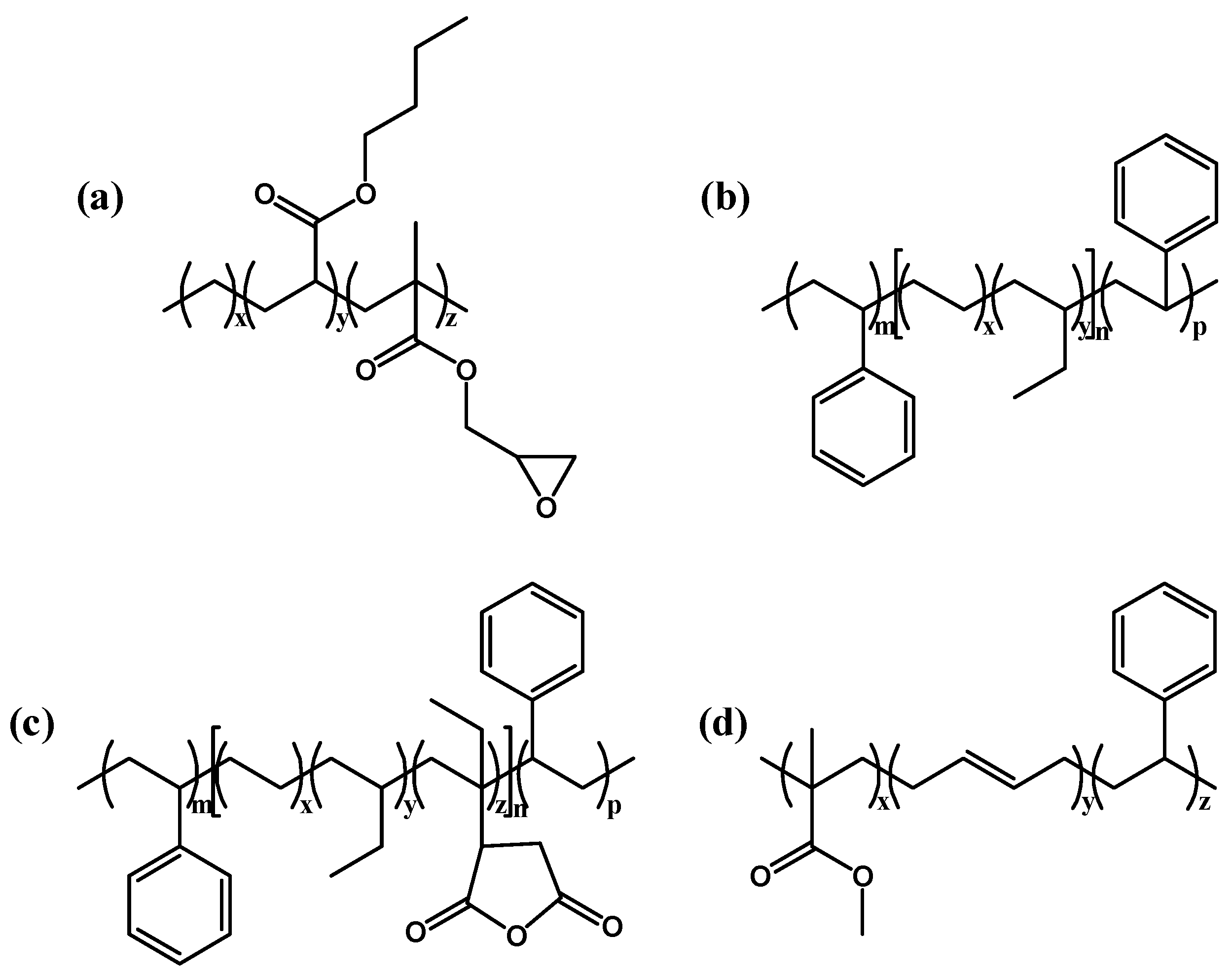


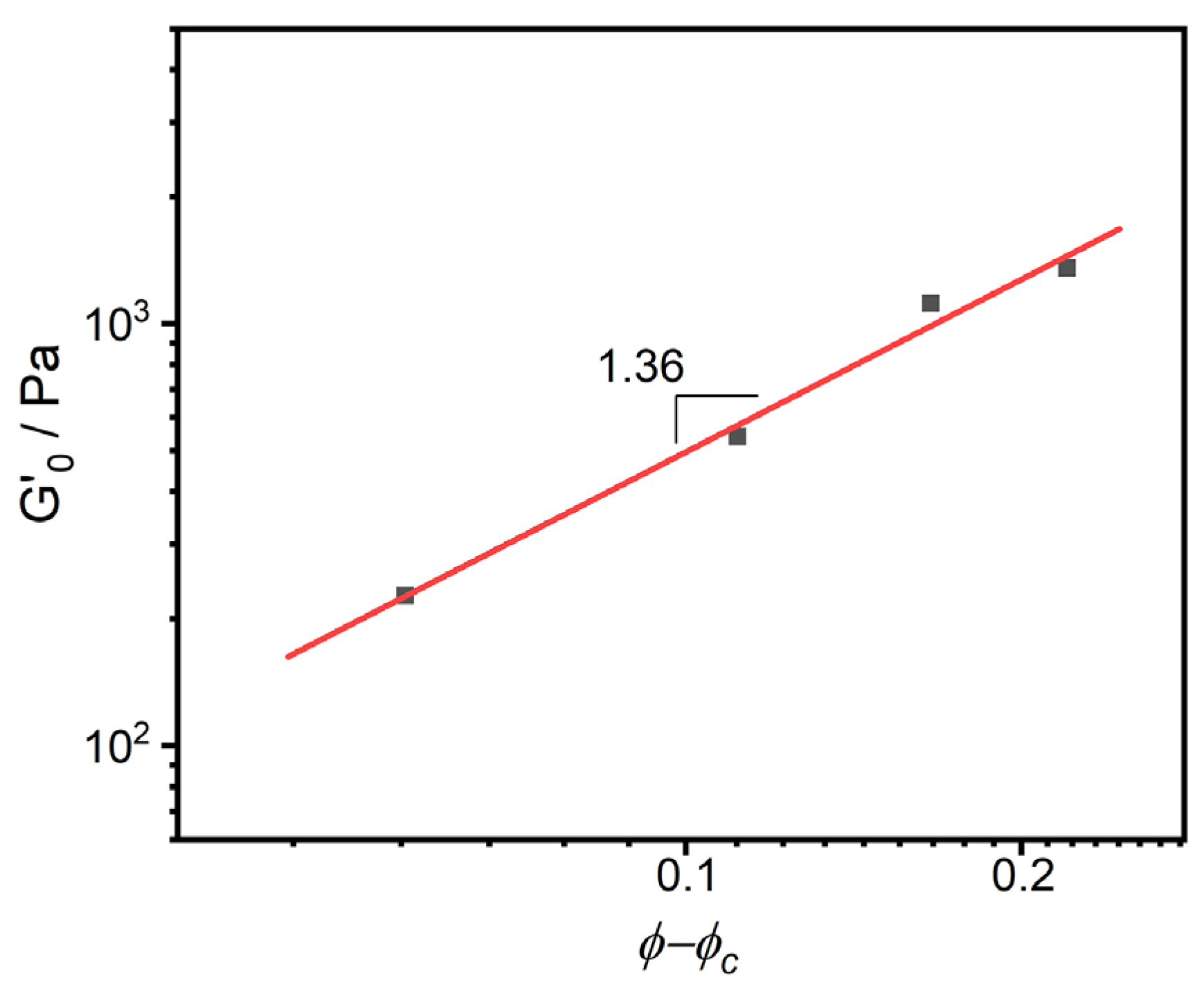

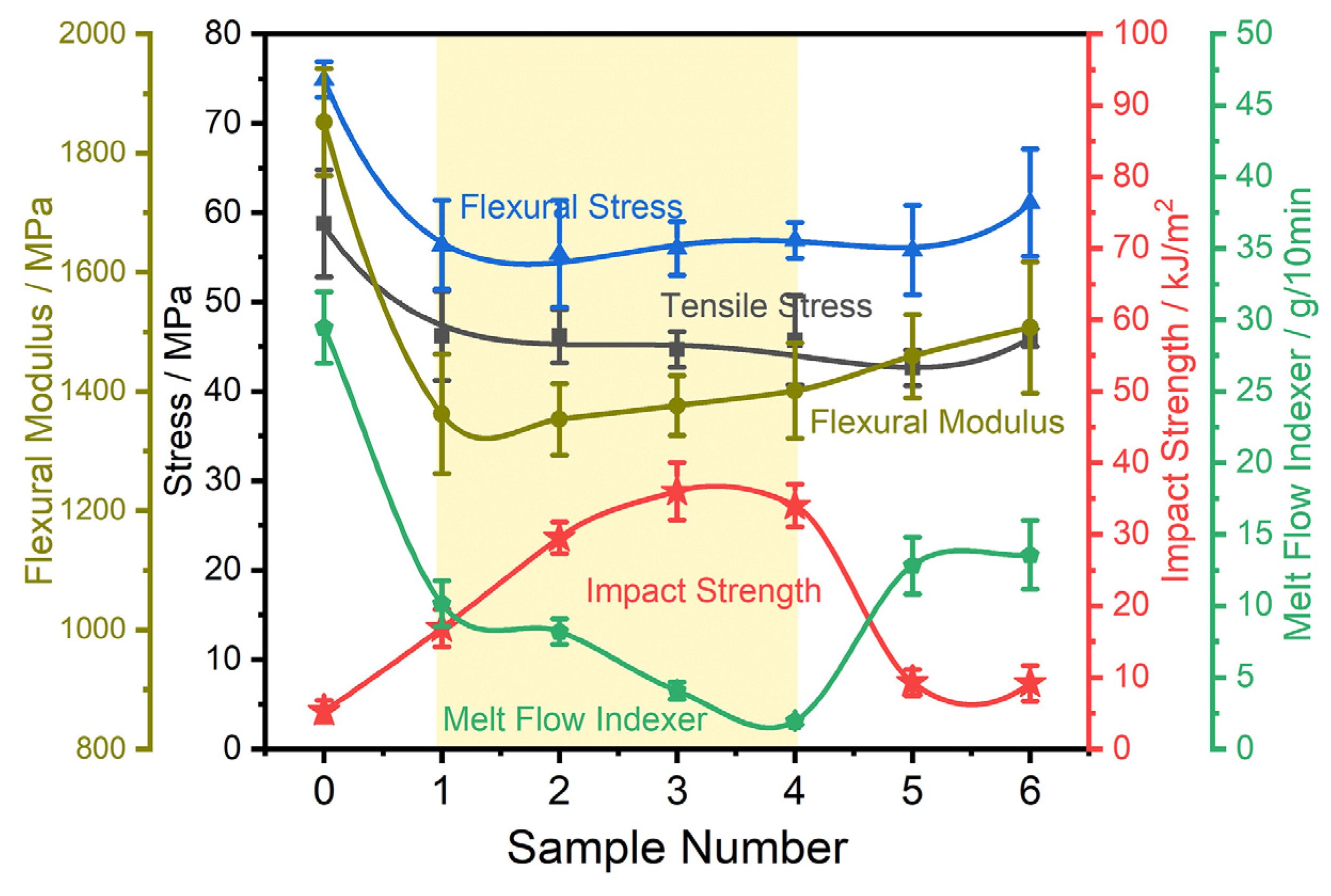
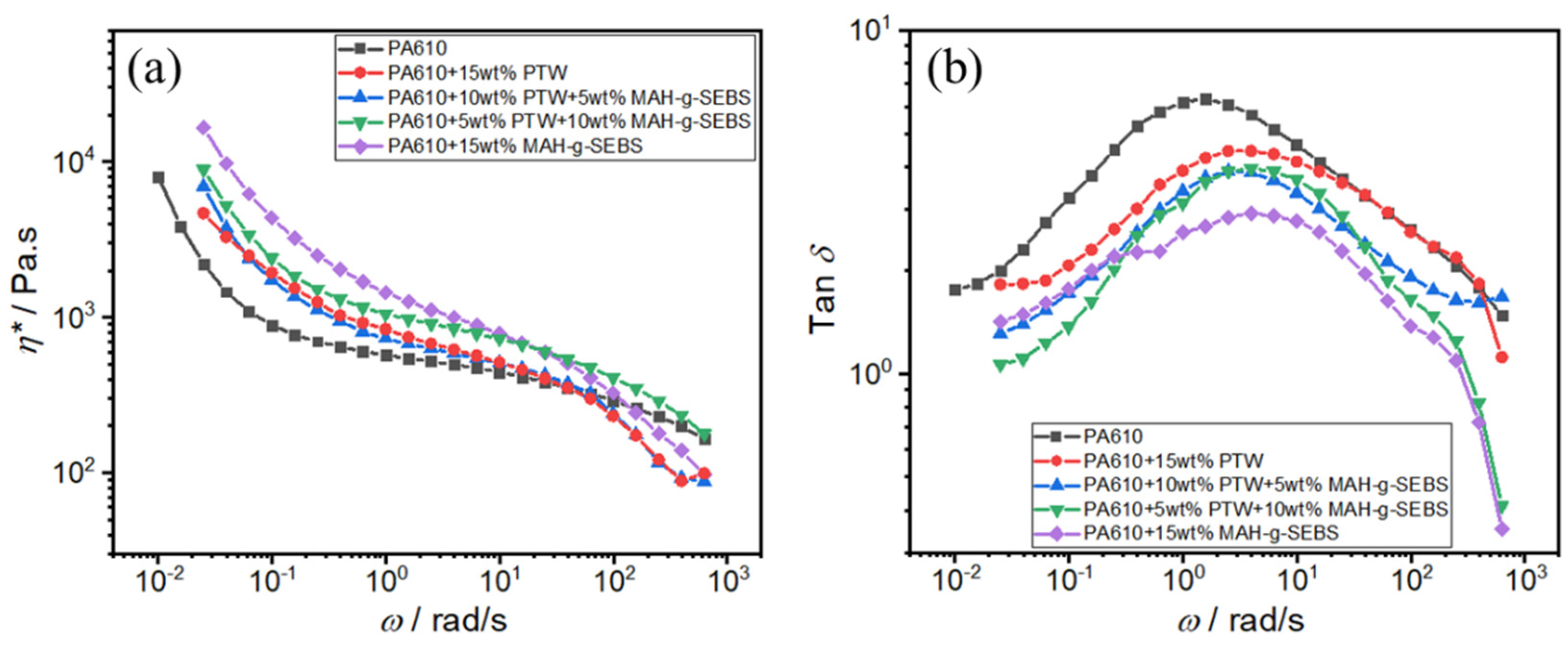
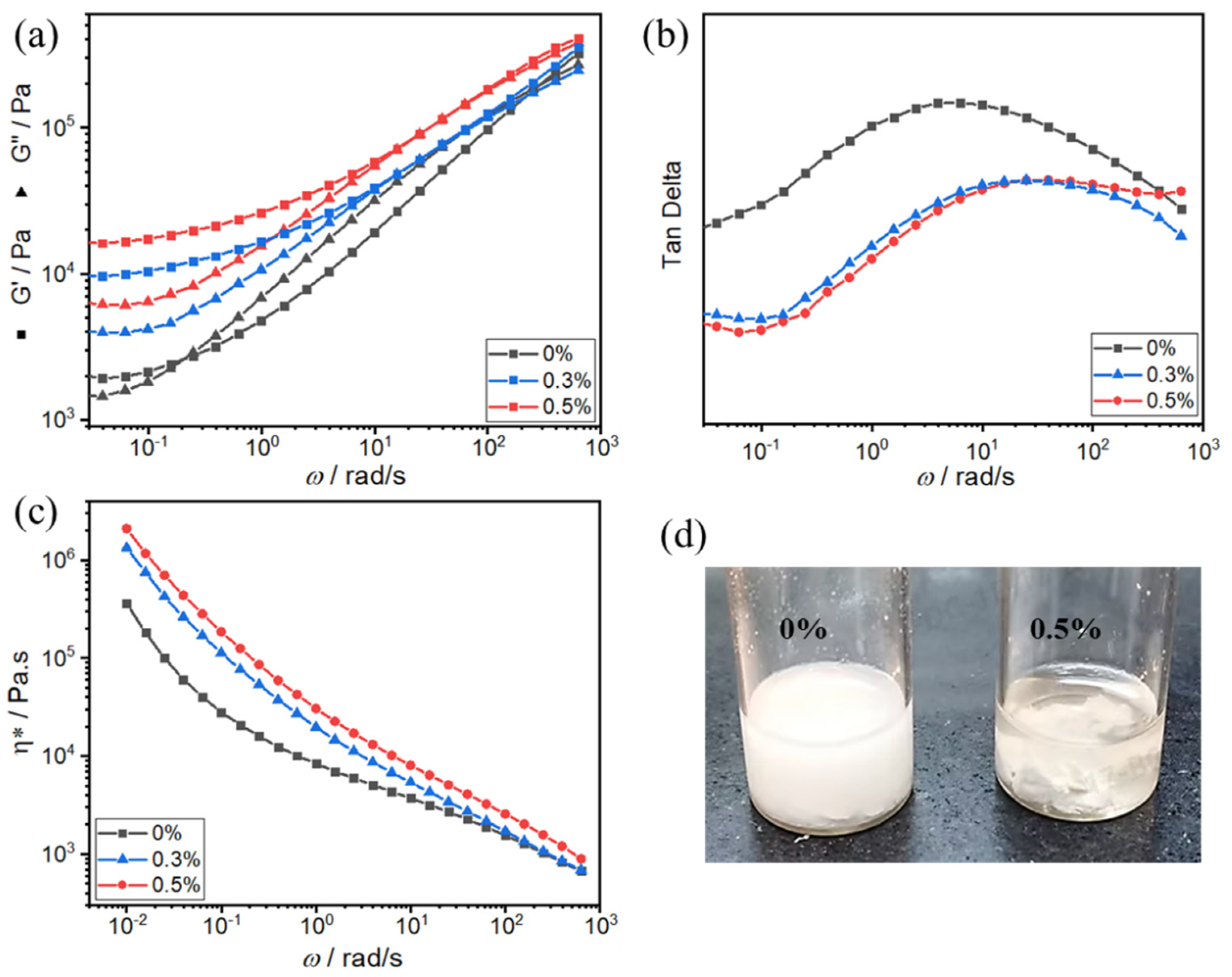
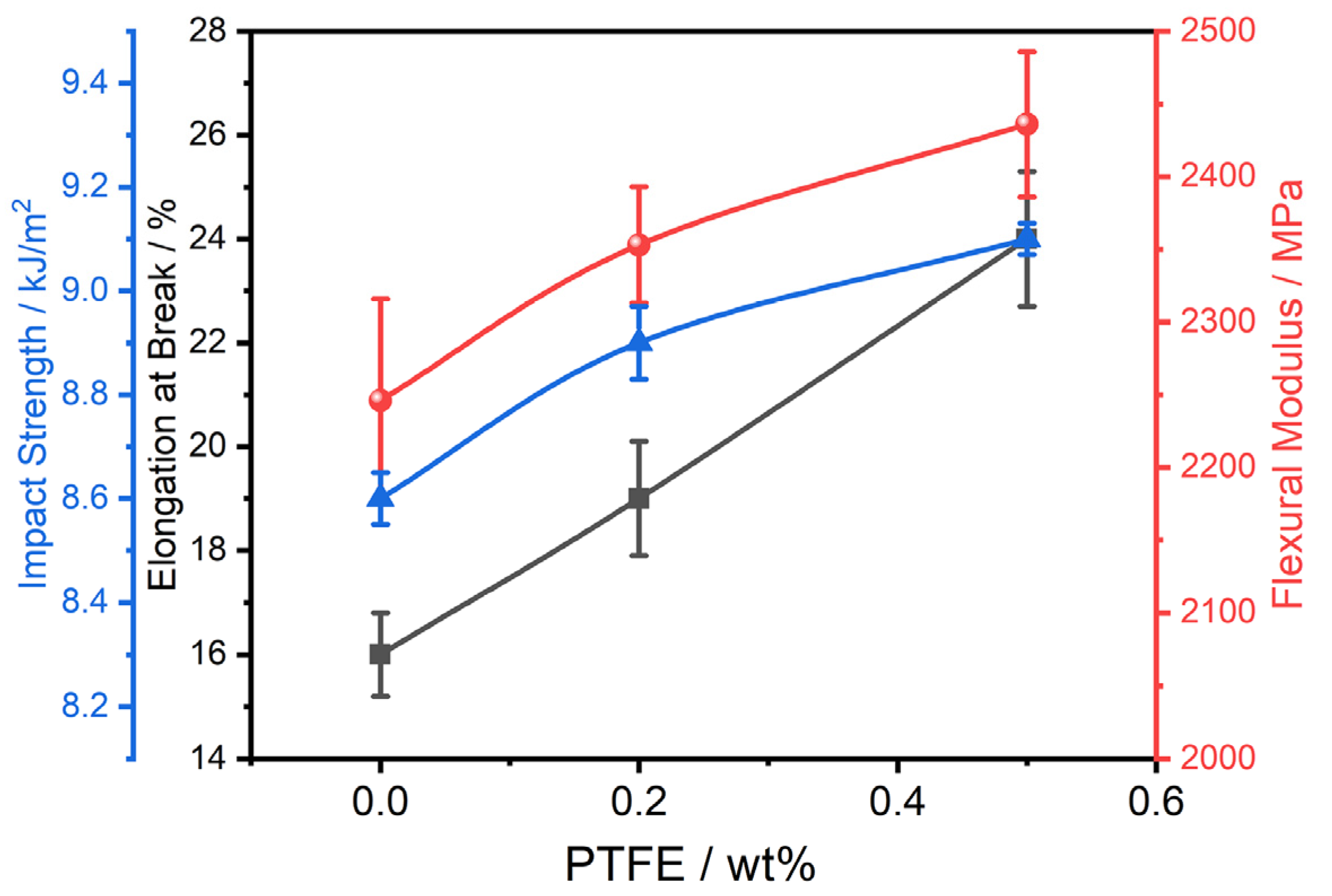
| a MFI (g/10 min) | b Tc (°C) | b Tm (°C) | c Tpeak (°C) | |
|---|---|---|---|---|
| PA610 | 23.7 | 179.9 | 222.9 | 481.9 |
| 1# | 2# | 3# | 4# | 5# | 6# | 7# | |
|---|---|---|---|---|---|---|---|
| PA610 | 99.5 | 84.5 | 84.5 | 84.5 | 84.5 | 84.5 | 84.5 |
| PTW | 15 | 10 | 5 | ||||
| MAH-g-SEBS | 5 | 10 | 15 | ||||
| SEBS | 15 | ||||||
| MBS | 15 | ||||||
| Irganox® 1098 | 0.5 | 0.5 | 0.5 | 0.5 | 0.5 | 0.5 | 0.5 |
| TR044W | 0.2 | 0.2 | 0.2 | 0.2 | 0.2 | 0.2 | 0.2 |
Disclaimer/Publisher’s Note: The statements, opinions and data contained in all publications are solely those of the individual author(s) and contributor(s) and not of MDPI and/or the editor(s). MDPI and/or the editor(s) disclaim responsibility for any injury to people or property resulting from any ideas, methods, instructions or products referred to in the content. |
© 2024 by the authors. Licensee MDPI, Basel, Switzerland. This article is an open access article distributed under the terms and conditions of the Creative Commons Attribution (CC BY) license (https://creativecommons.org/licenses/by/4.0/).
Share and Cite
Zhou, C.; Ding, C.; Yang, H.; Huang, X. Investigation of Dual Network Construction for Toughening in Bio-Based Polyamide Composites. Polymers 2024, 16, 2248. https://doi.org/10.3390/polym16162248
Zhou C, Ding C, Yang H, Huang X. Investigation of Dual Network Construction for Toughening in Bio-Based Polyamide Composites. Polymers. 2024; 16(16):2248. https://doi.org/10.3390/polym16162248
Chicago/Turabian StyleZhou, Chenxu, Chao Ding, Huaguang Yang, and Xianbo Huang. 2024. "Investigation of Dual Network Construction for Toughening in Bio-Based Polyamide Composites" Polymers 16, no. 16: 2248. https://doi.org/10.3390/polym16162248
APA StyleZhou, C., Ding, C., Yang, H., & Huang, X. (2024). Investigation of Dual Network Construction for Toughening in Bio-Based Polyamide Composites. Polymers, 16(16), 2248. https://doi.org/10.3390/polym16162248






